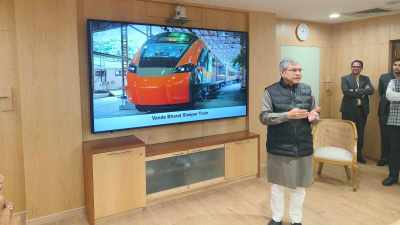The stability myth
One cardinal and unique feature of Indian politics is that here every political party is in power and in the opposition at the same time....

One cardinal and unique feature of Indian politics is that here every political party is in power and in the opposition at the same time. The BJP, Congress, the JD, the CPI M are all in power in some states and in opposition in some others. Socially too, almost all castes and community groups are at the helm of affairs in some states and at the receiving end in others. This makes Indian polity a compulsively federal one. It is understandable, therefore, that a melange of conflicting interests and issues should mark its functioning and should define electoral battles at each election time. It would also perhaps explain the instability that inheres in the very working of parliamentary democracy which is the polity8217;s operative instrument. One aspect of the instability is the frequency with which governments fall.
Has this inherent instability been necessarily detrimental to India8217;s economic development and political maturing? Let us examine the question first contra-factually, from the opposite end, as itwere. In the half century old history of the working of parliamentary democracy in India, there have inevitably been long periods of stability, as well as conditions on which prolonged stability is premised such as a decisive majority for a single party in the Lok Sabha; there have also been periods of considerable instability due to an uncertain verdict returned by the electorate. In the first three elections, between 1952 and 1962, the Congress was returned with comfortable majorities and fall of governments did not loom large on the political scene, except for the dismissal of the Communist government in Kerala in 1958 under article 356 by Jawaharlal Nehru.
The dream of rapid economic development following the path of a socialistic pattern of society8217; 8212; a typically Nehruvian compromise between what were then perceived as antagonistic developmental paths of free enterprise and the Soviet brand of socialism 8212; had on one hand created a miserable annual growth of around 3 per cent, derisively referredto as the Hindu rate of growth8217; and, on the other, led to a massive popular anger over rising prices in 1967 that swept off all the Congress governments from Punjab to West Bengal except at the Centre. The long stability had for sure allowed the nation to heal its wounds following the country8217;s tragic partition; but it had proved no sweet recipe for economic development.
In 1971 Indira Gandhi8217;s call for garibi hatao won her a massive mandate, perhaps a bit too massive for comfort, but this and her decisive intervention in the coming into existence of Bangladesh in the following year did not prevent the tide of economic discontent. The Railway strike of 1974 was its most visible manifestation. The mandate ended in the imposition of the Emergency in 1975. In 1984, Rajiv Gandhi won an even more massive mandate than his mother and promised to usher in the 21st century which in popular perception meant a clean, transparent government that would bring about rapid economic growth. Three years on, hisgovernment was in a shambles.
In the states too, the CPI M has created a history of sorts by providing the longest lasting stable government in independent India8217;s history 8212; Jyoti Basu has been chief minister for 22 long years. Has the stability of the West Bengal Government brought the state to the forefront of the country8217;s economic, political or social landscape? On all accounts the prolonged stability of government there has been accompanied by a low level economic equilibrium. Politically, the Left has remained lodged at the margins and quite content with that position. The BJP-Shiv Sena, too, have ruled Maharashtra for five years by now without a threat of fall or dismissal; this fact, however, has in no measure either created an economic miracle, reduced social turmoil, or improved the law and order scenario in the state.
On the other hand it was the minority government of Narsimha Rao which willingly or unwillingly brought about a break with the legacy of economic policies of the past andallowed a degree of liberalisation; the result has been some departure from the lines drawn by the Hindu rate of growth. And all reports on the economy in the current phase have indicated an upward movement in the past three months or so; these are the months of a government which had lost the confidence of the Lok Sabha 8212; in other words a most unstable and crippled government.
There does not appear then any necessary link between a stable government and economic growth. The converse is perhaps not true either: from this one can hardly infer that an unstable government is essential for economic growth or social stability. But making an issue of stability and implicitly blaming the illiterate Indian electorate for not providing the conditions for it does not get validated by history. Considering that there is now virtually a consensus on economic policies from BJP to CPIM with the Congress in-between, the assumption of political power by one party or another for whatever length of time should make littledifference to the question of economic growth. There is, in fact, a growing disjuncture between economy and politics.
In some ways the Indian polity has the resilience to initiate measures of economic growth and political maturing. Economic statistics apart, those of us who have grown to adulthood in the fifties and sixties would recall with distaste the picture of almost every finance minister, with his begging bowl, making a beeline to the West, especially the US, to ask for aid under one pretext or another. Much of India still remains desperately poor, but the begging bowl and the finance minister are no longer inseparable. The maturing of Indian parliamentary democracy, too, with all its shortcomings and flaws, does give one some sense of satisfaction.
Indeed, the Indian electorate has always responded enthusiastically every time issues over-riding caste, community or other narrow affiliations have been posed to it as in 1967 price rise, 1971 garibi hatao, 1977 the Emergency, and so on.It is always the absence of such issues that brings to the fore the electorate8217;s caste and community loyalties. As in the election now under way, an election in which the absence of issues on all sides seems to be the most visible issue.
The failure then has not lie in the structure of polity and in the political process; it has been one of good governance which comes with a vision, transparency and the impartial enforcement of laws. Good governance is not predicated upon one or other form of government: presidential, parliamentary, or any combination of these. There are numerous states in the world today that have experimented with virtually life long presidencies: they have had stability but not good governance.
The writer is a professor of history at JNU
- 01
- 02
- 03
- 04
- 05































